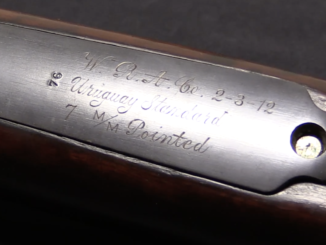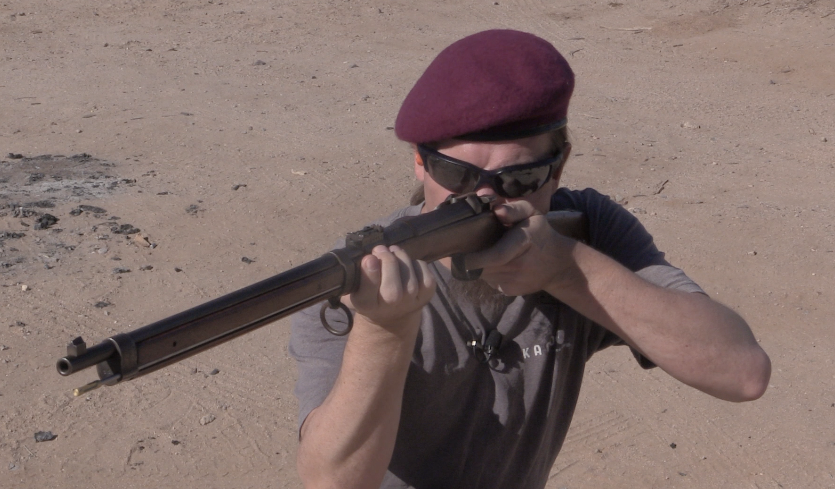The Celmi brothers were Italians who moved to Uruguay and opened an arms factory. They are best known for sporting shotguns, but in 1943 they introduced an automatic pistol, much like the Walther PP but with a removable barrel bushing, a la FN 1910. Quality was questionable, and only a few hundred were made, with the only known significant purchaser being the Uruguayan state oil company.
Related Articles

Bolt Action Rifles
Winchester Reference Collection: Uruguayan M1908 Short Rifle

Bolt Action Rifles
Uruguay’s Forgotten Mauser: the Dovitiis

Uncategorized

Were they made from steel salvaged from the Graf Spee? 🙂
I understand that the ejector is copied from Walter. Combined with slide stop.
An interesting story about an interesting attempt to make a simplified PP. Although with the loss of some useful functions.
John Semrad, I doubt it. The Royal Navy bought the wreck to investigate items of interest such as radar and didn’t sell it for scrapping until the Fifties
Who knows …
The time and place is right.
And the color of the handle (is it steel?) Is quite typical for chromium-manganese steels.
http://intelmsl.com/insights/4308/
A local intermediary could well have pushed the “extra iron” to the left.
Or possibly infusion of salts during carburizing. This color is visible on many Russian made firearms and not only on them.
Italians, huh? They are at the cradle of Bersa too, aren’t hey. Talented people to be sure.
In the first half of the twentieth century, “plum” was considered to be a desirable colour for high end sporting guns.
It appears as a finish on some very high quality German guns in particular.
That said, I don’t know whether it was popularly associated at that time with steel composition.
Here’s an example of a plum finish; check out the floor plate on the extended magazine of an original Schüler in 12.7×70.
I guess it helps if I get the link to post
https://www.westleyrichards.com/theexplora/vintage-500-magazine-rifles/
yes it does 🙂
A beautiful rifle, wood, metal… whole thing. Are they still making them?
There are currently several makers of high end Mauser 98 action clones, including the present iteration of the company bearing the “Mauser” name.
They’re available in all three lengths, with or without square top receiver bridges and rings.
The makers of bespoke rifles will happily make you just about whatever you want on one of them, and with your choice of engraving and finish.
Some of the temper blue finishes on the extractor and bolt stop springs, look almost as bright as anodized titanium.
The guys who do the brilliant blue, are the Saint Ledger brothers in Birmingham. They specialize in colour case hardening and other heat treatments, rather than chemical bluing and browning. I’m sure that someone can do a pleasing shade of “plum” either as a tempering colour or chemically.
The original 12.7x70mm Schüler rifles are particularly interesting.
Schüler, fitted one of the largest magazine rifle cartridges (even to this day!) Into a standard length ’98 action, and got it to work reliably.
I’ve not managed to get a good look at an original Schüler, yet.
Some of the accounts that I’ve read, suggest that it operates as a “push feed” rather than as a “controlled feed”. There’s something very interesting going on for it to feed that big, long, fat, rebated head case.
Here’s the website for one of the action makers https://mayfairengineering.com/components
Incidentally, there’s a pile of BS in books like Barnes; “Cartridges of the World”, suggesting that:
1) a lot of British and continental European chamberings are “Obsolete”. A lot of them are still being produced, but in very small numbers.
A lot of the larger chamberings were only produced in very small numbers, even at their peak of popularity, such as the. 500 Jefferey version of the 12.7mm Schüler, only 24 of the original rifles were produced.
2) Double rifles cannot handle the pressures of some of the magazine rifle cartridges…
While that might be true for a specific model of mass production gun, that might even be based on a shotgun action…
The bespoke makers will make you a double rifle chambered for any of the magazine rifle cartridges, of any head design, including the big Weatherby magnums, and even rimless and rebated head cases.
The rimless and rebated head extractors/ejectors are interesting. The blades that engage the extractor groove in the case head, actually cam into place as the action is closed.
Prices start at multiples of what I’m currently earning in a year 🙁
Well yes.
I can imagine how in the USSR parts of weapons are specially painted in different colors, just for beauty. 😉
Not to be confused with exclusive tailor shops.
In serious enterprises, there is only one blackening line. And the composition of the reagents in it is kept constant. This is cheaper and with more consistent quality.
Different color, solely the result of different steel composition.
https://weaponsofheroes.com/wp-content/uploads/2017/10/5-pistolet-tt-01-1024×682.jpg
The Rock Island Auction house had a 32 caliber Celmi back in 2015, but from their picture, it may be the very one that Ian had in his video: https://www.rockislandauction.com/detail/64/3394/rare-celmi-semiautomatic-pistol
It appears to be serial number 173/
A man named Jerry Farquhar, who was a member of the US Air Force Academy class of 1960, mentions having a Celmi 380 prototype pistol in his collecton in an article he wrote for the Academy website here:
http://www.usafaclasses.org/1960/Classnews/classnews_2012-02/Farquhar%20Gun%20Collection.htm
There is no picture of it. The article apparently dates from 2012. Mr. Farquhar says he got it from a friend named Buck Congdon, whose father received it “during his WWII service as head of Army Intelligence in Argentina”.